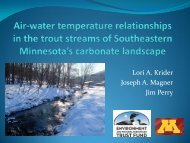Minnesota Water Resources Conference - Water Resources Center ...
Minnesota Water Resources Conference - Water Resources Center ...
Minnesota Water Resources Conference - Water Resources Center ...
You also want an ePaper? Increase the reach of your titles
YUMPU automatically turns print PDFs into web optimized ePapers that Google loves.
BOOK OF ABSTRACTS<br />
Tuesday, Monday, October 27 23<br />
Poster Session 4:45–5:45<br />
Degradation of Persistent, Bioaccumulative, and Toxic Compounds in Groundwater by Dehalococcideslike<br />
Organisms<br />
Mark Krzmarzick, University of <strong>Minnesota</strong>, krzma006@umn.edu; Paige Novak, University of <strong>Minnesota</strong>; Jevon Harding,<br />
Princeton University; Alessandra Leri, Princeton University; Satish Myneni, Princeton University<br />
Anthropogenic chlorinated compounds such as chlorinated ethenes, PCBs, and dioxins are often persistent,<br />
bioaccumulative and toxic (PBT). These compounds pose significant threats to surface waters and aquifers<br />
therefore low cost methods of remediation are of critical importance. This research tests the hypothesis that<br />
dehalorespirers, which are able to degrade several PBTs, are natural components of uncontaminated ecosystems<br />
and that their presence is linked to the existence of natural chlorinated organic compounds. Six soils cores were<br />
collected from an uncontaminated area of the New Jersey Pine Barrens. Quantitative real-time polymerase chain<br />
reaction has been used to quantify the numbers of Dehalococcoides-like species in the soil cores. These numbers<br />
will be correlated with the quantity of chlorinated organic matter. The ability of dechlorinators to respire<br />
natural chlorinated organics will be tested in batch reactors, which will enable more cost effective methods of<br />
stimulation for the degradation of anthropogenic PBTs.<br />
Expanding Stormwater Education and Outreach Through Private-Public Partnerships<br />
Kate Kubiak, South St. Louis Soil and <strong>Water</strong> Conservation District for the Regional Stormwater Protection Team, kate.kubiak@<br />
southstlouisswcd.org; Mindy Granley, <strong>Minnesota</strong> DNR Lake Superior Costal Nonpoint Pollution Control Program for the<br />
Regional Stormwater Protection Team<br />
The Regional Stormwater Protection Team is a cooperative effort between 26 communities and entities in<br />
the Twin Ports region of Duluth/Superior. The group’s mission is to protect and enhance the region’s shared<br />
water resources by providing coordinated educational programs and technical assistance aimed at reducing<br />
stormwater pollution. In an effort to expand its outreach, the group launched the Superior Streams Partner<br />
Program in 2008. This program seeks to involve businesses in reducing stormwater pollution by inviting them<br />
to support the group’s outreach efforts with a monetary donation and implementing stormwater BMPs in their<br />
business practices. Using the marketing plan created for the program in 2007, the group will implement the<br />
project over the spring and summer of 2008. Success will be determined by how many partnerships the group is<br />
able to develop and the degree to which the nature of those partnerships can or will lead to reduced stormwater<br />
pollution.<br />
Utilizing Beaver in Stream Restorations<br />
Terry Lee, Olmsted County, lee.terry@co.olmsted.mn.us<br />
Few animals have had as big an impact in shaping the landscape of North America as the beaver and few are as<br />
controversial amongst natural resource managers. Although the fur trade nearly decimated the beaver, today<br />
they are making a comeback. Scientists are beginning to value the role of beaver in stream ecosystems and<br />
resource managers in western states have begun to utilize them in stream restorations. This presentation will<br />
summarize information that could be used in evaluating utilizing beaver in <strong>Minnesota</strong> stream restorations.<br />
45 <strong>Minnesota</strong> <strong>Water</strong> <strong>Resources</strong> <strong>Conference</strong>, October 27–28, 2008
















